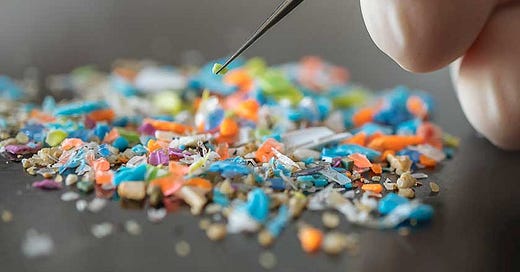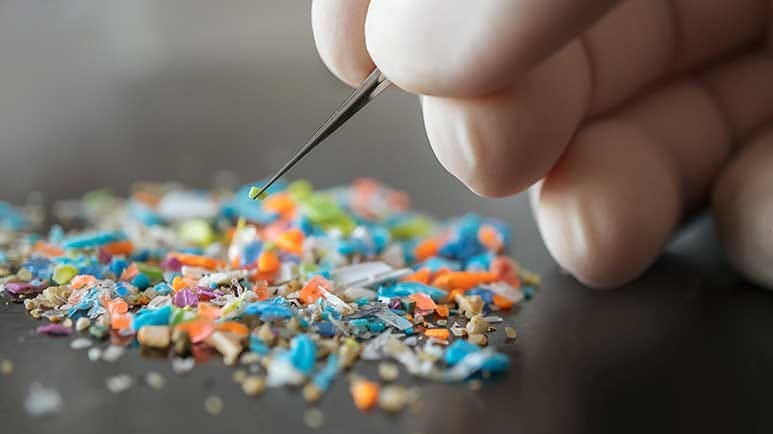How Microplastics Accumulate in Your Brain and Other Organs
Microplastics are a growing concern worldwide, and research is now showing that much of them are embedded in your brain, liver and kidneys.
STORY AT-A-GLANCE
Research reveals microplastics are increasingly present in human organs, with brain tissue containing seven to 30 times more microplastic concentration than liver or kidney samples taken from 2016 and 2024 studies
Microplastics originate from degrading plastic items and manufactured products, infiltrating oceans, soil and air, making them nearly impossible to avoid in our environment
Nanoplastics (under 100 nanometers) cross the blood-brain barrier within two hours, contributing to inflammation and neurodegenerative diseases like Alzheimer's through beta-amyloid peptide acceleration
Laboratory studies indicate microplastics affect multiple body systems, causing digestive inflammation, respiratory issues, endocrine disruption and reproductive disorders, though human research remains challenging
Practical ways to reduce exposure include filtering tap water, avoiding plastic packaging, using natural fiber clothing and choosing glass or metal containers over plastic ones
Most people enjoy eating seafood regularly or taking a relaxing, warm bath. While these seem harmless, research shows that they now come with an unseen invader — microplastics. These tiny plastic particles, often smaller than a grain of sand, are increasingly pervasive in our environment. In fact, they’re now in your brain and other organs.
Plastic Is Everywhere, and It’s Also in Your Brain
In a preprint study published in Research Square, researchers sought to find out the amount of micro- and nanoplastics (MNPs) currently embedded in the human body. For their experiment, they collected a total of 51 post-mortem tissue samples of liver, kidney and brain from 2016 and 2024. From there, the samples were subjected to a chemical test that created solid materials namely, polymer-based solids that can be detected by special equipment.1
The researchers discovered that the brain contains the highest concentration of MNPs — around seven to 30 times more — compared to liver or kidney samples. Moreover, the MNPs found in the brain typically range in the nanometer scale with shard-like properties. According to their findings:2
“A non-parametric analysis of variance (Kruskal-Wallis) confirmed that MNP concentrations in brains were significantly greater than all other tissues (P<0.0001).
Furthermore, from 2016 to 2024, there was a significant increase in MNP concentrations in both livers and brains. The predominant polymer found in all tissues was polyethylene, which independently displayed similarly increasing trends from 2016 to 2024 in the liver and brain.
The proportion of polyethylene in the brain (74%) appeared significantly greater relative to other polymers in comparison to the liver and kidney (44% to 57%), although kidney samples from 2024 also had increased relative PE (71%) …
The concentrations in liver and kidney were not as high (relative to brains) as we would have suspected, as these are ‘front line’ organs for xenobiotic uptake and clearance. That said, the lipophilic nature of plastics may make them easily handled by the liver, which has a major role in uptake and repackaging of dietary triglycerides and cholesterol.”
However, the researchers didn’t dive into the health effects of MNPs on human health, noting that this topic is better suited for a new study.3
Where Do Microplastics Come From?
Microplastics originate from various sources. Some are created when larger plastic items like bottles, bags and food packaging break down due to sunlight exposure, weathering and physical abrasion. Think of a plastic bottle left under the sun — it becomes brittle and eventually fragments into smaller and smaller pieces. These fragments are microplastics.
In other cases, microplastics are manufactured intentionally, such as microbeads used in certain cosmetics and personal care products (although many countries have now banned their use).
These tiny plastic particles have infiltrated nearly every corner of the environment. They’re found in our oceans, rivers and lakes, polluting the water and harming marine life. They’re also present in the soil, affecting plant growth and entering our food supply. Even the air you breathe contains microplastics, which lodge into your lungs when inhaled.4 This widespread contamination makes it nearly impossible to avoid exposure entirely.
When it comes to food, microplastics enter your system through various pathways. Marine animals, both predator and prey, ingest microplastics in the ocean, and these particles then accumulate in their tissues. This means that when you consume seafood, you’re also ingesting these microplastics.5
Similarly, microplastics in the soil are absorbed by plants, contaminating the growth and nutrition of fruits, vegetables and other crops.6 Plastic packaging used for food and beverages also shed microplastics, further contributing to your exposure.
Beyond food and water, you’ll encounter microplastics in many other everyday products, many of which you most likely own. For example, synthetic clothing, like polyester and nylon, sheds tiny plastic fibers during washing. These microfibers are a significant source of microplastic pollution in our waterways. While microbeads have been banned in many countries, some industrial processes still contribute to microplastic pollution.
Microplastics and the Brain
Again, one of the most concerning aspects of microplastic pollution is their ability to reach the brain. The brain is protected by the blood-brain barrier, which normally prevents many harmful substances from entering the delicate brain tissue. However, nanoplastics (less than 100 nanometers), are able to cross this barrier7 in just two hours after they enter the body.
The concern is that these microscopic particles pile up in the brain over time, a process known as bioaccumulation. While research regarding the health impacts of MNPs is not definite yet, researchers theorizes that they provoke the immune system, thereby causing inflammation.8 Chronic inflammation in the brain has been linked to various neurological problems.
While research is still ongoing, there is concern that long-term exposure to MNPs and their subsequent accumulation in the brain contribute to the development of neurodegenerative diseases like Alzheimer's.
As noted in an animal study published in the Journal of Hazardous Materials, once nanoplastics cross the blood-brain barrier, they contribute to neurotoxicity by accelerating the spread of beta-amyloid peptides, which is the main pathogenic protein of this condition.9
Unsolved Mystery — Researching the Impact of Microplastics
Studying the health effects of microplastics in humans is a complex challenge. It’s difficult to assess the impact of microplastics on human health because of ethical concerns.
This has caused scientists to resort to in vivo, in vitro and animal test models to monitor and study the impact of microplastics.10 But from this research, we’re now able to infer the likely consequences of microplastics on human health. Here’s what a 2023 study published in Yonsei Medical Journal have compiled:11
Digestive system — Microplastics cause physical irritation to the gastrointestinal tract, leading to inflammation and digestive symptoms. This results in an imbalance in your gut microbiota, causing abdominal pain, bloating and changes in bowel habits.
Respiratory system — The inhalation of microplastics causes oxidative stress in the airways, leading to coughing, sneezing and shortness of breath. Fatigue and dizziness will also occur due to low blood oxygen concentration.
Endocrine health — Microplastics interfere with hormone health, disrupting your endocrine function. This leads to metabolic disorders, developmental problems and even lower fertility rates. Much of the reason for this is because microplastics typically have bisphenol A, a chemical that greatly affects endocrine health and the reproductive system.
Addressing the issue of microplastic pollution and its potential health impact requires collaborative efforts between scientists, governments and industries. Scientists need to conduct more research to understand the health effects, governments need to implement policies to reduce plastic pollution, and industries need to develop more sustainable alternatives to plastic.
“Considering the ubiquitous nature and long persistence of microplastics, it is necessary to make efforts to mitigate their exposure given their effects on entire generations and multiple generations.
In the future, in-depth research on the pollution status and hazards of marine microplastics, as well as the correlation between exposure to microplastics and diseases in humans, should be conducted; and based on these findings, human health should be protected by preventing and managing microplastics,” the researchers concluded.12
Take Control of Your Health in a Plastic World
While research is still ongoing, it’s clear that having foreign, microscopic objects embedded in your organs is not good for your health, or anyone’s health for that matter. Therefore, it’s important to take proactive steps to minimize your exposure while scientists continue to investigate the long-term effects.
Addressing the problem of microplastic pollution requires a collective effort. By combining individual actions with broader policy changes and industry innovation, we’ll move towards a future with less plastic contamination and a healthier environment for everyone. But in the meantime, implementing practical strategies at a personal level will help reduce microplastic exposure. Here are my top recommendations:
Filter your tap water and avoid water bottled in plastic — If you need to buy bottled water, opt for glass bottles. Also make sure the filter you use to purify your tap water can filter out microplastics.
Boil hard tap water — If you have hard tap water, consider boiling it before using it for cooking or drinking, as hard water traps more microplastics. Recent research shows boiling hard tap water for five minutes removes up to 90% of the microplastics in the water.
Avoid plastic packaging — Opt for products packaged in glass, metal, or paper instead of plastic. This can significantly reduce the amount of plastic waste that breaks down into microplastics. At home, use wax paper, parchment paper or paper bags to store foods rather than plastic wrap.
Use reusable containers — Replace single-use plastic bottles, cups, and containers with reusable alternatives made from safer materials like stainless steel or glass.
Never microwave plastics — Heat can cause plastics to leach chemicals into food. Use glass or ceramic containers for microwaving.
Avoid plastic cutting boards — Use a wooden or glass cutting board instead.
Opt for natural fibers — Whenever possible, choose clothing and other textile products made from natural fibers like cotton, wool and linen, as synthetic fabrics such as polyester shed microfibers and leach xenoestrogens.
Wash synthetic clothes less frequently — When washing synthetic textiles, use a microfiber filter in your washing machine to trap synthetic fibers and prevent them from entering the water system.
Opt for food grade cosmetics and personal care products — Some cosmetics, toothpastes, and personal care products contain microbeads or other plastic particles. Look for products free of these materials. Ideally, opt for all-natural, food grade products.
Choose your children’s toys carefully — Replace plastic toys with those made from safe, nontoxic and sustainable materials.
Opt for natural cleaning products — Chemical cleaning products like soaps, cleansers and surface cleaners, usually contain microplastics and phthalates that affect your endocrine system. Replace them with natural alternatives like white vinegar, baking soda and essential oils.
Disclaimer: The entire contents of this website are based upon the opinions of Dr. Mercola, unless otherwise noted. Individual articles are based upon the opinions of the respective author, who retains copyright as marked.
The information on this website is not intended to replace a one-on-one relationship with a qualified health care professional and is not intended as medical advice. It is intended as a sharing of knowledge and information from the research and experience of Dr. Mercola and his community. Dr. Mercola encourages you to make your own health care decisions based upon your research and in partnership with a qualified health care professional. The subscription fee being requested is for access to the articles and information posted on this site, and is not being paid for any individual medical advice.
If you are pregnant, nursing, taking medication, or have a medical condition, consult your health care professional before using products based on this content.





